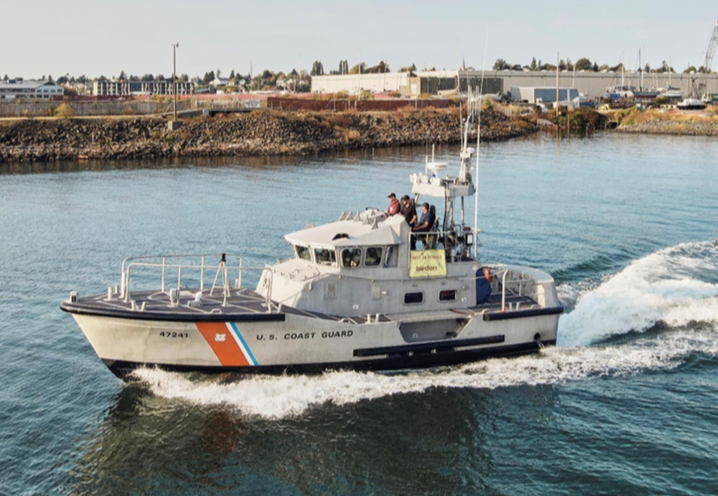The Coast Guard recently accepted Birdon America Inc.'s 47C MLB SLEP First Article Vessel at the National Motor Lifeboat School (NMLBS) in Ilwaco, Wash., completing the first significant milestone in the Motor Lifeboat Service Life Extension Program (MLB SLEP).
The 47'x14' aluminum boat will undergo a four-month operational assessment at the Coast Guard's NMLBS. The West Coast shipyard is All American Marine, Bellingham, Wash. The $190 million 10-year contract, awarded in August 2019, will extend the useful life of MLBs by 20 years on a minimum of 107 MLBs and a maximum of 117.
Denver-based Birdon America designed the 47C configuration of the 47 MLB for optimal performance, crew safety and ergonomics, and fuel economy. The systems are designed to reduce Total Ownership Cost (TOC) and improve reliability and maintainability.
With a 4'6" draft, the 47' boat is designed to weather hurricane force winds and heavy seas, capable of surviving winds up to 60 knots, breaking surf up to 20' and impacts up to three Gs. If the boat should capsize, it self-rights with all equipment remaining fully functional. The 47C MLB SLEP will provide the Coast Guard with many years of extended service and improved performance from a proven hull form.
Main propulsion is provided by twin Cummins QSC8.3 diesel engines, producing 530 hp at 2,800 rpm each within a standard V-drive/shaft/propeller propulsion system configuration. The mains are connected to ZF 27"x27.75" nibral, 4-bladed props through ZF 370V marine gears with 2.00:1 ratios. The lifeboats have a running speed of 26 knots. Glen Denning G226 handle the electronic throttle system controls and Jastram the steering system.
The 47C meets the U.S. Coast Guard technical requirements and exceeds requirements in the areas of fuel economy and noise. The boat is fitted with new consoles, navigation systems, fire suppression systems, crew seating, lighting, power generation, and electrical system components.
The boats carry a crew of four with room for five passengers, Capacities include 400 gals. of fuel. Raymarine supplied the electronics suite. Ancillary equipment includes SHOX seats, FireBoy fire suppression and alarm systems, ConNav autopilot, Victron energy power management, and Harken tow reels.
“Birdon America is proud to have delivered this new capability and looks forward to the Operational Assessment and a long-term relationship with the Coast Guard,” Jim Ducker, president, Birdon America, said in a statement announcing the delivery. “The 47C MLB configuration represents a significant upgrade in overall performance for this very capable and familiar vessel to the Coast Guard. This is just the beginning of a long process to upgrade the entire fleet of 47 MLB vessels and Birdon is ready to move forward with this transformation.”
Birdon America's 47 MLB SLEP contract includes design and development, 2-D/3-D drawing package, technical publications, vessel transportation, training, insurance stock spare parts, and various technical deliverables. The SLEP activities are performed on the West Coast in Bellingham, Wash., and will begin East Coast operations in 2022 for boats located there.
The design for the 47C MLB configuration was primarily completed using Birdon's internal team of naval architects and engineers, with support from major component suppliers.
Birdon is a diversified global group of companies providing whole of life solutions to the maritime, military and resource sectors. Birdon America is also the designer and manufacturer of the U.S. Army Bridge Erection Boat (BEB) — 140 BEBs have been delivered to date. Ongoing production in the Denver facility will deliver over 300 additional boats in the next five years.




